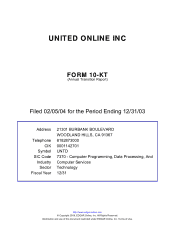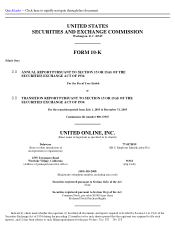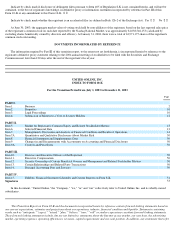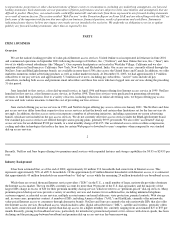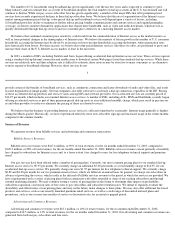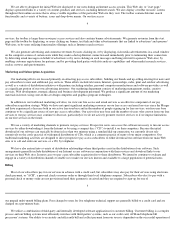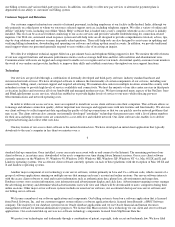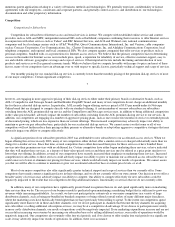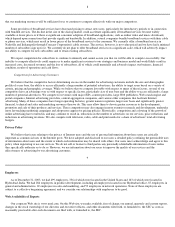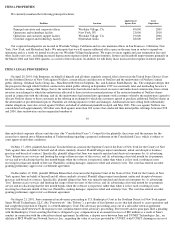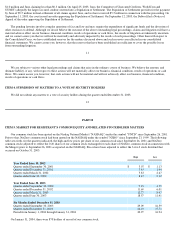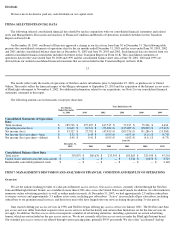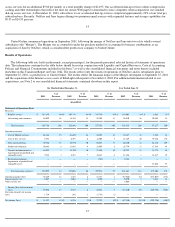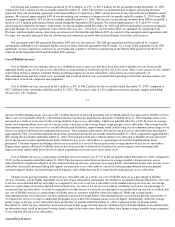Classmates.com 2003 Annual Report Download - page 6
Download and view the complete annual report
Please find page 6 of the 2003 Classmates.com annual report below. You can navigate through the pages in the report by either clicking on the pages listed below, or by using the keyword search tool below to find specific information within the annual report.
We are able to designate the initial Web site displayed to our users during an Internet access session. This Web site, or "start page,"
displays sponsored links to a variety of content, products and services, including Internet search. We also display a toolbar on users' screens
throughout their online sessions that is always visible regardless of the particular Web site they visit. The toolbar contains Internet search
functionality and a variety of buttons, icons and drop-down menus. On our free access
4
services, the toolbar is larger than on our pay access services and also contains banner advertisements. We generate revenues from the start
page and the toolbar by displaying, or users clicking on, banner, text-link and other advertisements that are linked to advertisers' and sponsors'
Web sites, or by users utilizing functionality offerings such as Internet search services.
We also generate advertising and commerce revenues by users clicking on, or by displaying, rich media advertisements in a small window
on the computer screens of certain users while they make a dial-up Internet connection and immediately prior to terminating their connection;
by delivering email messages on behalf of advertisers or by users clicking on such messages and being referred to sponsors' Web sites; by
enabling customer registrations for partners; and by providing third parties with data analysis capabilities and other market research services,
such as surveys and questionnaires.
Marketing and Subscription Acquisition
Our marketing efforts are focused primarily on attracting pay access subscribers, building our brands and up selling existing free users and
pay subscribers to new and additional pay services. These efforts include television, Internet, sponsorships, radio, print and outdoor advertising
as well as a variety of distribution initiatives with partners including retailers, personal computer manufacturers and software providers as well
as a significant portion of our own advertising inventory. Our marketing department consists of marketing management, media, creative
services, Web development, strategic alliance and business development personnel. We produce a significant amount of our marketing
materials in-house, using state-of-the-art design computers and graphics program techniques.
In addition to our traditional marketing activities, we view our free access and email services as an effective component of our pay
subscriber acquisition strategy. While we have not spent significant marketing resources on our free access and email services since the Merger
and have experienced a decrease both in our active free user base and in the number of people signing up for free services, our free user base
continues to be a significant source of new pay access subscribers. Our active free user base and the number of users who convert from our free
services to our pay services may continue to decrease, particularly if we do not actively promote our free services or if we impose limitations
on our free services in the future.
We use a variety of marketing channels to promote our pay services. Prospective users can access the software necessary to run our access
services by either downloading it from the Internet or by using a compact disc ("CD") to install it on their computers. Because the initial
download of our software can typically be done in less than two minutes using a standard dial-up connection, we currently do not rely
extensively on the costly practice of widespread distribution of CDs, which is a common practice of many of our major competitors. Our
traditional marketing activities are designed to drive prospective pay access subscribers to either download our software from our main Web
sites or to call and order our services, or a CD, by telephone.
We have also entered into a variety of distribution relationships where third parties assist in the distribution of our software. Such
arrangements generally include distribution of our Internet access software in conjunction with their services and download links to our
services on their Web sites. In most cases we pay a per subscriber acquisition fee to these distributors. We intend to continue to evaluate and
engage in a variety of distribution channels to enable us to make our services known and available to a large population of potential users.
Billing
Most of our subscribers pay for our services in advance with a credit card, but subscribers may also pay for their services using electronic
check payment, or "ACH", a personal check or money order or through their local telephone company. Subscribers who elect to pay with a
personal check or money order are not provisioned until their payment is received and they are required to sign-up for one of
5
our prepaid multi-month billing plans. Fees charged to users for live telephone technical support are generally billed to a credit card and are
charged on a per-minute basis.
We utilize a combination of third-party and internally developed software applications for customer billing. Customer billing is a complex
process and our billing systems must efficiently interface with third-parties' systems, such as our credit card, ACH and telephone bill
processors' systems. Our ability to accurately and efficiently bill and collect payment from our users is dependent on the successful operation of

